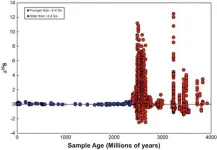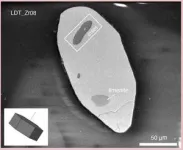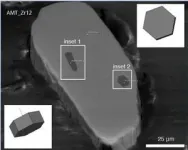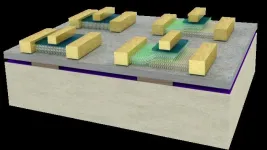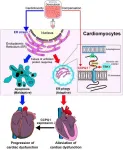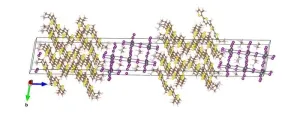(Press-News.org) An international team of scientists have uncovered an important link between Earth’s early atmosphere and the chemistry of its deep mantle.
The study, which was led by researchers at the University of Portsmouth and University of Montpellier, sheds new light on the evolution of life on our planet and the rise of atmospheric oxygen.
The team investigated magmas formed in ancient subduction zones, where portions of Earth’s crust sink back into the mantle, from a pivotal moment in Earth's history – the Great Oxidation Event (GOE). This event, which is estimated to have happened between 2.1 and 2.4 billion years ago, was a period of time when oxygen levels in Earth's atmosphere increased rapidly and transformed life and environments on Earth.
However, there has been little research into how atmospheric changes have left their mark on the Earth’s mantle.
The new study, published in the journal Nature Geoscience, examined the role of plate tectonics – the process by which our planet's outer shell moves and reshapes its surface – in cycling and exchanging elements between the atmosphere, Earth's surface, and the deep mantle. Until now, reliable methods to understand these interactions were elusive.
By studying magmas from before and after the GOE, the team found a shift from reduced to more oxidised magmas. This was a result of the deep subduction of oxidised sediments from mountains transformed into sediments during weathering and erosion that were then recycled into the mantle via subduction processes – revealing how sediment recycling provided atmospheric access to the mantle.
This discovery implies that these ‘whiffs’ of oxygen may have changed the mantle by contributing to increased oxidation of calc-alkaline magma, altering the composition of the continental crust, and leading to the formation of ore deposits on Earth.
Lead author, Dr Hugo Moreira from the University of Montpellier and visiting researcher at the University of Portsmouth, said: “With these findings, our understanding of Earth's ancient ‘breath’ has taken a significant leap forward. Not only does it provide crucial insights into Earth's geological evolution, but it also sheds light on how the deep Earth and its mantle are intimately connected to atmospheric changes. It provides us a better understanding of the relationship between Earth's external and internal reservoirs.
“Moreover, it raises fascinating questions about the role that oxygen played in shaping our planet's history and the conditions that paved the way for life as we know it.”
The research team used the ID21 beamline at the European Synchrotron Radiation Facility in France to analyse sulphur state in minerals found in two-billion-year-old zircon crystals from the Mineiro Belt in Brazil, which acted as time capsules, preserving their original composition. They discovered that minerals from magmas that crystallised before the GOE had a reduced sulphur state. However, after the GOE, these became more oxidised.
Dr Moreira said: “Mantle oxygen fugacity, in simple terms, is a measure of oxygen's ability to drive chemical reactions in magmas and is critical for understanding volcanic activity and ore formation. However, in the past, we lacked a reliable way to track changes in this parameter for ancient parts of Earth’s history – until now.
“It provides a powerful tool for understanding the relationship between Earth's external and internal reservoirs. Sulphur speciation and magma fugacity are dynamic parameters that can change throughout a magma's journey from formation to crystallization. While our study considered factors like pressure and temperature, further analyses are needed to trace the complete ‘fugacity path’ from magma generation to final crystallisation.”
Co-author Professor Craig Storey, Professor of Geology at the University of Portsmouth, said: “Our study opens exciting new avenues of research, offering a deeper understanding of the Earth's ancient past and its profound connection to the development of our atmosphere. It challenges us to ponder questions about the evolution of magma types over time and the intricate interplay between plate tectonics and atmospheric cycles.”
Dr Moreira added: “As we continue to probe the mysteries of Earth’s geological history, one thing is certain - there is much more to discover beneath the surface.”
The study involved researchers from the University of Portsmouth, the Universities of Brest, Montpellier and University of Sorbonne, (France), the Federal University of Ouro Preto and University of São Paulo (Brazil) and the European Synchrotron Radiation Facility.
END
New research reveals Earth's ancient ‘breath’: Study reveals connection between atmospheric changes and mantle chemistry
2023-08-31
ELSE PRESS RELEASES FROM THIS DATE:
Discovery opens possibility of new ion channel-targeting drugs
2023-08-31
Ion channels are attractive drug targets due to their importance in health and disease, but finding ways to target a specific ion channel selectively is a major challenge. Now, researchers at Weill Cornell Medicine and RMIT University in Australia have discovered that ion channels called BK channels have unique openings in their sides, which drug molecules may be able to access. The finding, published Aug. 31 in Nature Chemical Biology, could lead to the development of selective drugs that target the BK channel to treat ...
Analog and digital: The best of both worlds in one energy-efficient system
2023-08-31
We live in an analog world of continuous information flow that is both processed and stored by our brains at the same time, but our devices process information digitally in the form of discrete binary code, breaking the information into little bits (or bites). Researchers at EPFL have revealed a pioneering technology that combines the potential of continuous analog processing with the precision of digital devices. By seamlessly integratingultra-thin, two-dimensional semiconductors with ferroelectric materials, the research, published in Nature Electronics, unveils a novel way to improve energy efficiency and add new functionalities in computing. The ...
Coastal fisheries show surprising resilience to marine heat waves
2023-08-31
Rutgers-led research found that marine heat waves – prolonged periods of unusually warm ocean temperatures – haven’t had a lasting effect on the fish communities that feed most of the world.
The finding is in stark contrast to the devastating effects seen on other marine ecosystems cataloged by scientists after similar periods of warming, including widespread coral bleaching and harmful algal blooms.
“There is an emerging sense that the oceans do have some resilience, and while they are changing in response ...
A new breakthrough in obesity research allows you to lose fat while eating all you want
2023-08-31
This is a significant development that brings hope to the one billion individuals with obesity worldwide. Researchers led by Director C. Justin LEE from the Center for Cognition and Sociality (CCS) within the Institute for Basic Science (IBS) have discovered new insights into the regulation of fat metabolism. The focus of their study lies within the star-shaped non-neuronal cells in the brain, known as 'astrocytes'. Furthermore, the group announced successful animal experiments using the newly developed drug 'KDS2010', which allowed the mice to successfully achieve weight loss without resorting ...
New blood test for noncoding RNA significantly improves cancer detection
2023-08-31
Cancer is most treatable in its early stages, so finding innovative and non-invasive methods to diagnose cancer early on is crucial for fighting the disease. Liquid biopsies, which require just a simple blood draw, are an emerging technology for non-invasively testing for cancer using DNA or RNA sequencing of a patient’s blood.
Assistant Professor of Biomolecular Engineering Daniel Kim and his lab are developing more accurate and powerful liquid biopsy technologies that take advantage of signals from RNA “dark matter,” an understudied ...
Largest genetic study of epilepsy to date provides new insights on why epilepsy develops and potential treatments
2023-08-31
Thursday, 31 August 2023: The largest genetic study of its kind, coordinated by the International League Against Epilepsy, including scientists from FutureNeuro at RCSI University of Medicine and Health Sciences, has discovered specific changes in our DNA that increase the risk of developing epilepsy.
The research, published today in Nature Genetics, greatly advances our knowledge of why epilepsy develops and may inform the development of new treatments for the condition.
Epilepsy, a common brain disorder of which there are many different types, is known to have genetic component and to sometimes run in families. Here, researchers compared the DNA from diverse groups of almost ...
Intracellular recycling: the key to surviving potent anti-cancer drugs
2023-08-31
Researchers from Tokyo Medical and Dental University(TMDU) determine how cardiomyocytes protect themselves against anti-cancer medication
Tokyo, Japan – A cell contains many specialized subunits, called organelles, that carry out important tasks such as energy generation, protein synthesis, and calcium outflux. But what happens when something goes wrong with one of the organelles?
In a study recently published in the Journal of the American College of Cardiology: CardioOncology, researchers from Tokyo Medical and Dental University(TMDU) have ...
Growing triple-decker hybrid crystals for lasers
2023-08-31
By controlling the arrangement of multiple inorganic and organic layers within crystals using a novel technique, researchers at Duke University and Purdue University have shown they can control the energy levels of electrons and holes (positive charge carriers) within a class of materials called perovskites. This tuning influences the materials’ optoelectronic properties and their ability to emit light of specific energies, demonstrated by their ability to function as a source of lasers.
Appearing online August 31 in the journal Nature Chemistry, the research is the result of a close collaboration between several ...
Positive framing of genomics met with scepticism in some communities
2023-08-31
August 31, 2023 - New research published today in Human Genetics and Genomics Advances reveals the difference between ‘what we say’ and ‘what people hear’ when engaging underrepresented communities around genomics and healthcare.
Genomics datasets, which underpin the ability to interpret all genetic tests, are known to consist of DNA from predominately white, Northern European populations. As genomics becomes an increasingly important part of everyday healthcare*, barriers to diverse participation must be overcome so that everyone can benefit from genomic medicine, not just the privileged few.
The research ...
People who are in good shape take fewer mental-health related medication
2023-08-31
“We find that people who are in better shape fill fewer prescriptions for anxiety and depression medications,” says Linda Ernstsen, the senior author of the article and an associate professor from the Department of Public Health and Nursing at the Norwegian University of Science and Technology (NTNU).
The research group based its work on the Trøndelag Health Study (HUNT). Since 1984, 250,000 Trøndelag residents have voluntarily contributed their health data to this comprehensive ...
